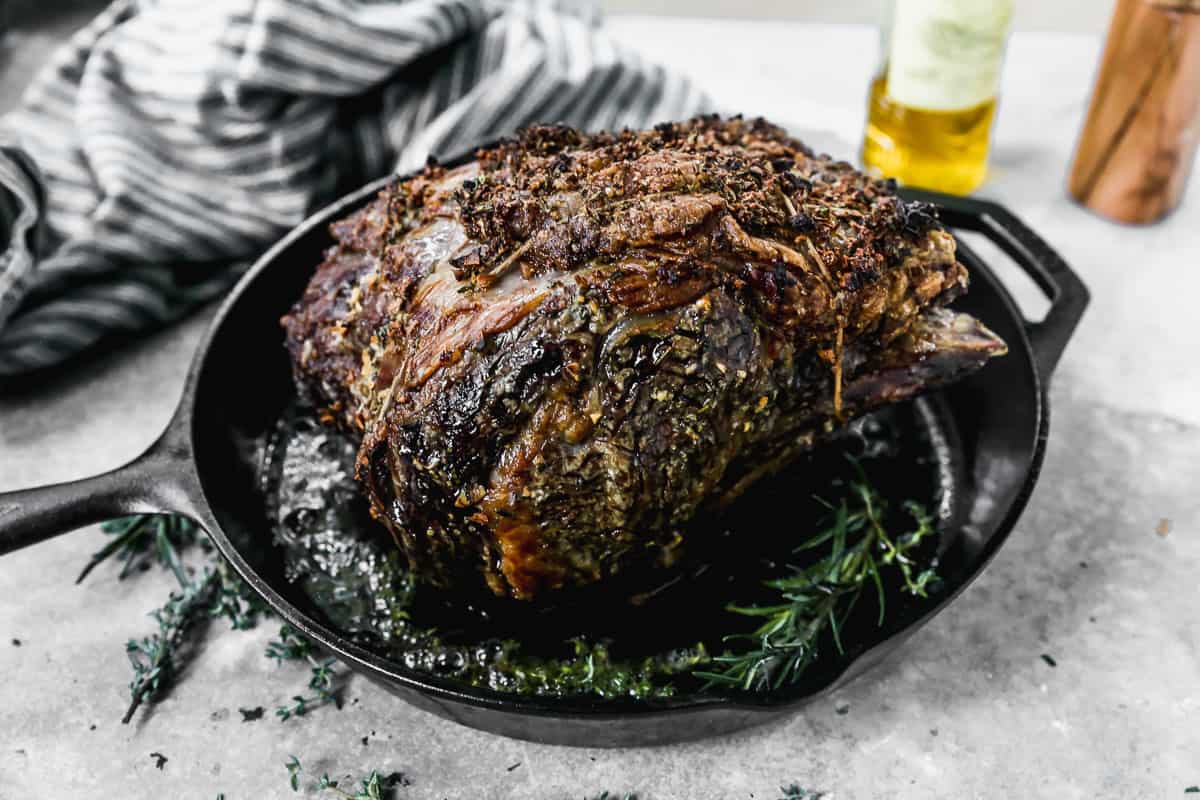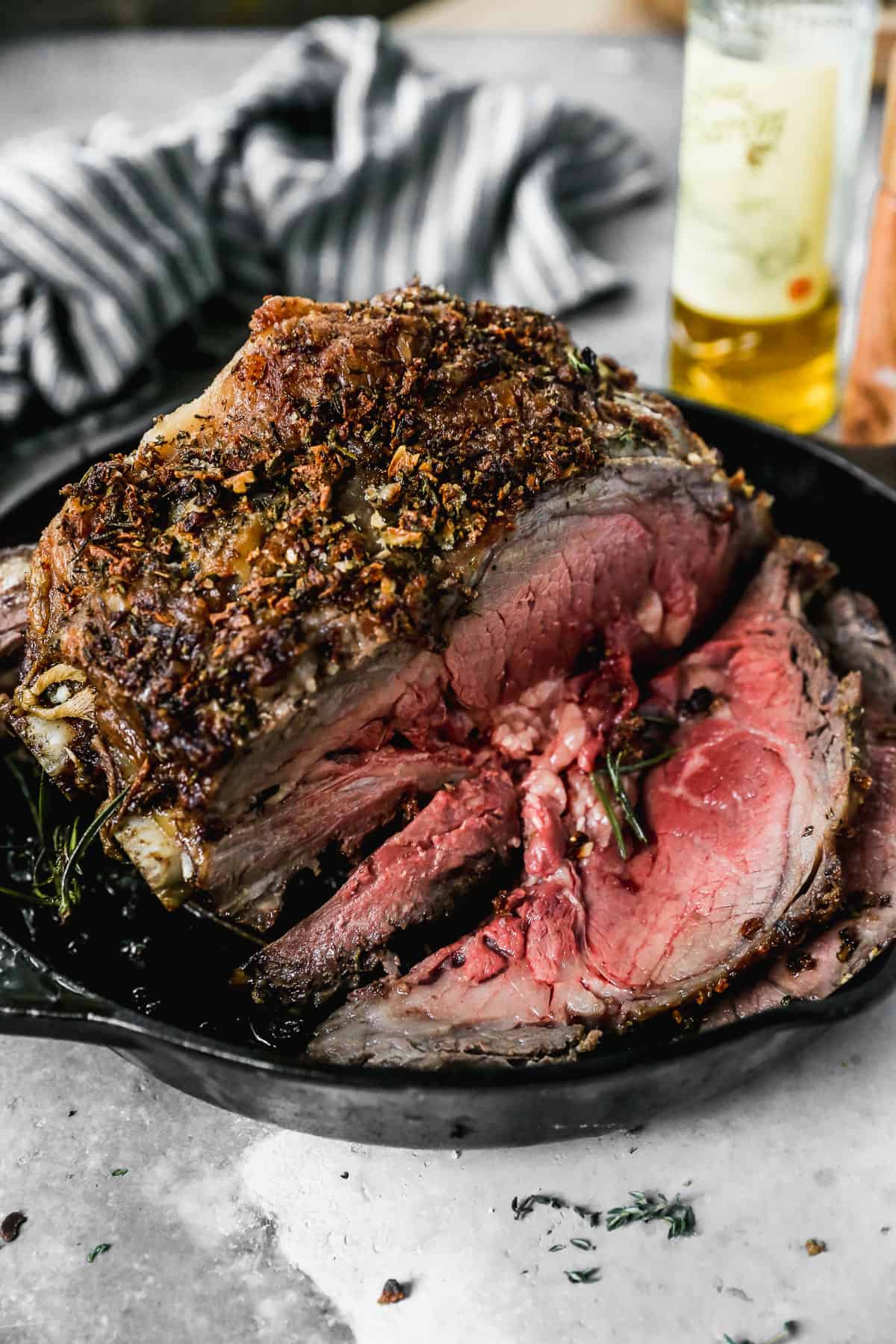The Perfect Prime Rib – the 5 Star Stunner
Prime Rib – America’s Favorite
Prime Rib Recipe
How much do you need?
The rule of thumb for buying prime rib is to buy one pound per person. A bone-in standing rib roast will feed about 2 people per bone. Also, be sure to consider how many side dishes you plan to serve. If you are preparing a large holiday meal with plenty of other food you could plan on ½ – ¾ pound prime rib per person.
The Prime rib roast (aka standing rib roast) is taken from the back of the upper ribs of the cow and typically makes up about 7 ribs. You don’t have to buy the whole section, just specify to your butcher how many pounds you would like.
Bone-in or Boneless Prime Rib:
Bone-in prime rib roasts are typically more flavorful and cook better than boneless prime rib, but boneless will also work great! If you buy a bone-in prime rib, ask the butcher to cut the bone off and tie it to the roast for you. This way you can cook the bones with the meat: they make a nice rack for the meat to sit on, but then you can easily remove them before carving the roast. If using a boneless prime rib, you will want to set it on a rack to roast. (I’ve had success using the wire rack from my instant pot set on top of my cast iron skillet.)
- 5 pounds beef prime rib* (if larger, double the spices/seasonings)
- Sea salt
- 2 teaspoons freshly ground black pepper
- 2 teaspoons fresh rosemary
- 1 teaspoon fresh thyme
- 8 cloves garlic , minced
- 1/4 cup olive oil
- horseradish , for serving (optional)
- Bring meat to room temperature: Remove prime rib from the refrigerator one hour before cooking. Season it on all sides with salt and cover it loosely with plastic wrap as it comes to room temperature. Prime rib roast will cook better and more evenly when it’s at room temperature.
- Adjust oven racks: When you are ready to cook the prime rib, lower/adjust your oven rack so the meat will cook in the center of the oven. Preheat the oven to 500 degrees F.
- Combine seasonings: In the meantime, mix together 1 ½ teaspoons salt, pepper, rosemary, thyme, garlic, and olive oil.
- Prepare roast: Pat the roast with paper towels. Spoon seasoning over it, rubbing it onto all sides. Place bone-in roast with the bones down, inside a roasting cast iron pan. Place a boneless roast on a rack inside the pan.
Bake prime rib at 500 degrees for 15 minutes, then reduce the oven temperature to 325 degrees and continue baking until desired level of doneness. Use a meat thermometer to check the temperature of the meat:
- Rare: 120 degrees F (about 10-12 min/pound).
- Medium Rare: 130 degrees F (about 13-14 min/pound)
- Medium: 140 degrees F (about 14-15 min/pound)
- Medium Well:150 degrees F
Important: The meat will continue to cook as it rests out of the oven so remove it from the oven 5-10 degrees before it reaches your optimal temperature.)
-
Rest: Remove it from the oven and tent it with foil. Allow it to rest for 30 minutes before carving.
-
Carve prime rib roast by slicing against the grain into about ½ inch thick slices. Serve with horseradish, if desired.
Notes
Prime Rib: Use bone-in or boneless prime rib for this recipe, but I recommend bone-in for a more flavorful roast. If you buy a bone-in prime rib, ask the butcher to cut the bone off and tie it to the roast for you. This way you can cook the bones with the meat: they make a nice rack for the meat to sit on, but then you can easily remove them before carving the roast. If using a boneless prime rib, you will want to set it on a rack to roast. (I’ve had success using the wire rack from my instant pot set on top of my cast iron skillet.)
Cook Time and Temperature:
The length of time to cook prime rib depends on how rare you want the meat.
Start by cooking your prime rib at 500°F for 15 minutes and then lower the oven temperature to 325° F and cook for 10-12 min per pound for rare, or 13-14 min per pound for medium rare, or 14-15 min per pound for medium well.
A meat thermometer is essential to ensure you cook it perfectly!
Roast your prime rib until the thermometer registers:
- 115-120˚F for rare
- 125-130˚F for medium rare
- 135-140° F for medium
- 145-150 F° for medium well
Please keep in mind the meat temperature will continue to rise 5-10 degrees when it’s resting out of the oven, so don’t over cook it!
How to cook Prime Rib:
Let it rest. Remove your roast from the refrigerator about 1 hour before cooking to give it time to come to room temperature. Season it with a little bit of salt and cover it lightly with plastic wrap while is rests.
Prepare herb rub. Combine the salt, pepper, fresh thyme, rosemary, garlic and olive oil then rub it all over the outside of the roast. Place a bone-in roast with the bones down, in a cast iron, roasting, or other oven safe pan. Place a boneless rib roast on top of a rack, and then in your pan.

Cook the boneless or bone-in prime rib at 500 degrees for 15 minutes and then reduce the oven temperature to 325 degrees and continue cooking until the meat is 5-10 degrees away from the desired doneness temperature (see cooking temperature guidelines above or below in the recipe card).
Allow time to rest. Remove the prime rib from the oven then tent the entire roast with foil. Allow it to rest for 30 minutes–It will continue to cook the extra 5-10 degrees. Resting the meat is essential as it allows the juices to seal back into the meat. If you cut the meat too soon, the juices will run out and it will be chewy.

Tips for Perfect Prime Rib:
- Use a meat thermometer. You can use a probe that stays inside the meat the entire time it cooks or you can use a simple instant read meat thermometer to check the prime rib cooking time. Either way, remember that each slice of meat is different and each oven is different. Don’t take the chance of ruining such an expensive piece of meat.
- Don’t over-cook. The meat will continue to cook once it’s taken out of the oven (your thermometer will continue to rise 5-10 degrees) so err on the side of taking your prime rib out early. If you take it out and it seems under-cooked, you can always cook it a little longer.
- Let it REST, As with most meat, you want to let it rest after cooking to allow the juices to settle in the meat, making it juicier and more tender. If you cut into your roast without letting it rest, the juices will rush out then the meat will be chewy.
- Cut meat across the grain. That means, notice the directional lines in the meat grain then slice perpendicular to them. If you cut along the grain then the meat will be tougher and chewier to eat.
Carve and Serve. Spoon some of the extra sauce from the pan over the roast, if desired, or use it to make gravy. Cut the kitchen string holding the roast to the bones (if using a bone-in roast) and remove the bones before carving. Serve the best prime rib recipe with mashed potatoes, wedge salad, and homemade rolls.
Why I love this recipe:
- Easy: Cooking prime rib can seem intimidating, especially since it’s an expensive cut of meat! But this recipe has simple ingredients and easy to follow instructions that will allow even the most novice cook to have success!
- Cheaper cooked from home: it’s much cheaper to serve prime rib from home, then order from a restaurant! Most local grocery stores carry choice grade prime rib for between $14.99 to $15.99 per pound. I’ve found Costco to have the lowest prices for the best quality. They even sometimes carry prime grade meat.

